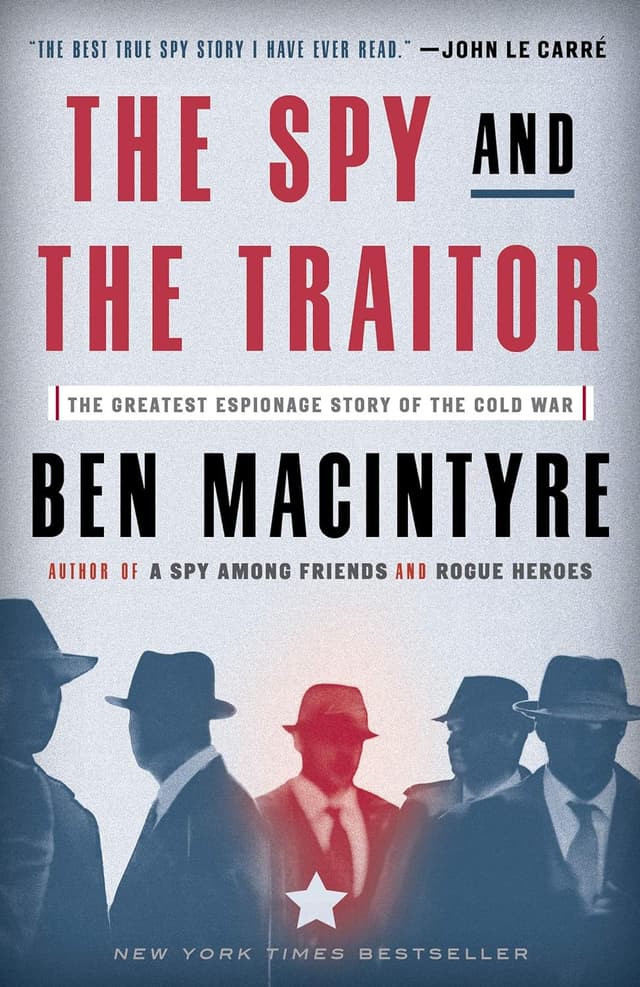Noah Brier | March 27, 2019
Why is this interesting? - Wednesday, March 27
On Cold War spycraft and intrigue
Recommended Products

It’s a story of a highly trained Russian KGB agent that gets a taste of the West on assignment, likes what he sees, and leverages his moral issues with communism into a prolonged cooperation with British intelligence service MI6. The book delves into the Cold War era, exposing Russian spies and helping to foil countless intelligence plots, as it details the partnership between the KGB defector and MI6.
I’ve been asked how to submit links for the email. If you’ve got something, just send it over to either Colin or I and we’ll get it slotted in. We’d love the help. Also, people have asked who’s writing what, the initials are meant to signal that. I - Noah - am NRB and Colin is CJN (Colin’s got the top section today). If you’ve got a better idea of how to distinguish we’d loved to hear it. - Noah (NRB)
I just finished reading one of the best books I’ve read in a long time, The Spy and the Traitor by Ben MacIntyre.
It’s a story of a highly trained Russian KGB agent that gets a taste of the West on assignment, likes what he sees, and leverages his moral issues with communism into a prolonged cooperation with British intelligence service MI6.
From the abstract:
“For nearly a decade, as the Cold War reached its twilight, Gordievsky helped the West turn the tables on the KGB, exposing Russian spies and helping to foil countless intelligence plots, as the Soviet leadership grew increasingly paranoid at the United States's nuclear first-strike capabilities and brought the world closer to the brink of war.”
Why is this interesting?
Russia and Britain have a complicated relationship. Whether it was the recent attempted poisonings of a former KGB defector or everything that happened with investor Bill Browder that led to Magnitsky law, the animosity and intrigue between the countries runs deep. And those are just the stories we know about.
The Spy and the Traitor reads like a real-life le Carré novel, with MI6 playing its part by trading secrecy and security for some of the most high profile intelligence the world has ever seen. In fact, the book enters stranger than fiction territory when Aldrich Ames, the notorious CIA traitor, is the one that eventually lets the Russians know they have a mole. I won’t get into the cloak and dagger back and forth, as you will hopefully read it yourself, but it’s very interesting to view every development with the West and Russia knowing this secret history. (CJN)
Photo Illustration of the Day:
Via New York Times on SV’s obsession with stoicism. (NRB) (Are those Albirds? - CJN)

Quick Links:
Brian Stetler has more on the News+ announcement from Apple, specifically digging in on the economics behind the inclusion of WSJ content. Despite the $9.99 a month price tag (vs $39 from WSJ.com), News+ subscribers will have full access to WSJ content. That’s a pretty intriguing deal. (NRB)
Kate Wagner of McMansionHell rips The Vessel a new one for The Baffler. “It is a Vessel for the depths of architectural cynicism, of form without ideology and without substance: an architectural practice that puts the commodifiable image above all else, including the social good, aesthetic expression, and meaningful public space. It is a Vessel for the architecture of views, perhaps the hottest spatial commodity of all.” (NRB)
This review of White by Bret Easton Ellis is amazing. Andrea Long Chu is both funny and insightful in her takedown of Ellis and his new book. Here’s a snippet: “The thesis of White is that American culture has entered a period of steep, perhaps irreversible decline, and social media and millennials are to blame. This is ridiculous, not because social media hasn’t changed things tremendously, but because such claims are invariably rooted in a childish nostalgia for an uncomplicated mode of human communication that has never, in fact, existed. One supposes that the last freethinking men of ancient Sumer, lamenting that cuneiform had ruined their political discourse, must have longed for the good old days of throwing rocks at each other’s heads.” (NRB)
This is terrifying: After diagnosing over 100 cases of measles, Rockland County, New York has declared a state of emergency and barred unvaccinated minors from public spaces. (NRB)
Quote of the Day:
Yesterday I wrote about Marshall McLuhan. I ended up in a Twitter back-and-forth with his grandson Andrew and was reminded of this quote from Douglas Coupland’s biography of McLuhan that helps explain why he still reads so relevant. (NRB)
“Marshall was also encountering a response that would tail him the rest of his life: the incorrect belief that he liked the new world he was describing. In fact, he didn’t ascribe any moral or value dimensions to it at all–he simply kept on pointing out the effects of new media on the individual. And what makes him fresh and relevant now is the fact that (unlike so much other new thinking of the time) he always did focus on the individual in society, rather than on the mass of society as an entity unto itself. It was Marshall’s embrace of the individual–a poetic and artistic, highly humane embrace–that has allowed the reader (then and now) to enter his universe. There are, perhaps, no practical political, religious, or financial applications to Marshall’s work. It could even be argued that it should be seen as a rarefied artifact unto itself, an intricate and fantastically ornate artwork that creates its own language and then writes poetry with it. And what would be wrong with that? Art is art. And an artist, according to Marshall, is someone on the frontiers of perception, who looks at information overload with the goal of pattern recognition, to see things before anyone else.”
Thanks for reading,
Noah (NRB) & Colin (CJN)